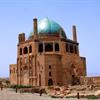A mausoleum is an external free-standing building constructed as a monument enclosing the interment space or burial chamber of a deceased person or people. A monument without the interment is a cenotaph. A mausoleum may be considered a type of tomb, or the tomb may be considered to be within the mausoleum. A Christian mausoleum sometimes includes a chapel.
Mausoleums
-
 5
5Dome of Soltaniyeh
The central magnet of Soltaniyeh's several ruins is the Mausoleum of Il-khan Oljeitu also known as Muhammad Khodabandeh, traditionally known as the Dome of Soltaniyeh in Soltaniyeh city, Zanjan Province.
-
 10
10Mausoleum of Mohammed V, Rabat
The Mausoleum of Mohammed V is a historical building located on the opposite side of the Hassan Tower on the Yacoub al-Mansour esplanade in Rabat, Morocco.
-
 10
10Mausoleum of the First Qin Emperor
The Mausoleum of the First Qin Emperor (Qin Shi Huang) is located in Lintong District, Xi'an, Shaanxi province of China. This mausoleum was constructed over 38 years, from 246 to 208 BCE, and is situated underneath a 76-meter-tall tomb mound.
-
 10
10Mosque of the Barber (Mausoleum of Sidi Sahab), Kairouan
Northwest of the medina is this 17th-century place tiled in luminescent colours and known as the 'barber mosque', because it contains the mausoleum of one of the Prophet's companions, Abu Zama el-Belaoui, who used to carry around three hairs from the Prophet's beard.
-
 8
8Samanid Mausoleum
The Samanid mausoleum is located in a park just outside the historic urban center of Bukhara, Uzbekistan. The mausoleum is considered to be one of the most highly esteemed work of Central Asian architecture, and was built between 892 and 943 A.D as the resting-place of Ismail Samani.
-
 10
10Taj Mahal
The Taj Mahal is an ivory-white marble mausoleum on the south bank of the Yamuna river in the Indian city of Agra. It was commissioned in 1632 by the Mughal emperor Shah Jahan, to house the tomb of his favorite wife, Mumtaz Mahal.
-
 5
5Tomb of King Kongmin
The Tomb of King Kongmin, more correctly known as the Hyonjongrung Royal Tomb, is a 14th-century mausoleum located in Haeson-ri, Kaepung County just outside the city of Kaesong, North Korea.
-
 6
6Tomb of King Wanggon
The Tomb of King Wanggon, more correctly known as the Hyollung Royal Tomb, is a mausoleum located Haesong-ri, Kaepung County near Kaesong, North Korea.


